
brought to the screen by Director Jerzy Hoffman
Peter K. Gessner
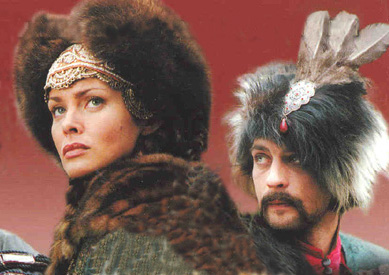 Hania and Bahun |
The story line has two strands - one the warfare occasioned by the Cossack uprising of 1648 in the Ukraine, the other, that of two men, rivals in war who fall in love with the same woman. Izabella Scorupco as the. heroine Helena is both beautiful and refined, as well as brave. She becomes the object of pursuit by the two very different suitors: Bohun a Cossack who grew up with the family with whom Helena lived with after she was orphaned by the death of her parents, and Skrzetuski, the Polish Noble who, while on a mission into the Ukraine meets Helena and soon discovers that they are in love.
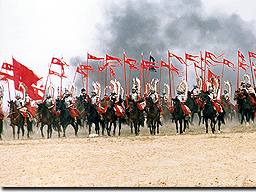 Husaria - Polish heavy cavalry |
The Cossack uprising or rebellion marks the beginning of modern Ukrainian consciousness, though at the time the ethnicity of the Cossacks was a very very fluid concept. . It was as much about class as about ethnicity and religion. Led by Chmielnicki, the Cossack War Lord, it had the Tartars joining the Cossack cause. The Cossack Rebellion cannot be compressed into a short story. But, employing a huge cast and thousands of extras and the most exciting cinema-photographic equipment and techniques, Hoffman draws the audience into the very center of the very real action. The battle scenes alone are worth the price of the ticket; above all see the huiai horod, a mobile siege tower. For its time it was a very unique seize weapon.
Among the many other colorful characters portrayed in the film is Zagloba, a, Pole, who, described as a resembling Shakespear's Falstaff, provides lighter moments during the more serious ones. Michal Wolodyjowski, another Pole, is the consummate noble knight. Although small in stature he is the most outstanding fighter with a sword. A very interesting member of the cast is Longimus Podkopieta, also a Pole. He. compares well with Don Quixote. His name Longimus describes him as very well. His sword has a character of its own and Longimus uses it very effectively. Chmielnicki himself is portrayed as someone who at times in his life wanted to be a Polish nobleman, and at other times, utterly frustrated, sought to destroy Poland.
The initial screening of the film attracted 330,000 persons for its audience; American action thrillers which are usually are the main fare of Polish Cinema goers; they just don’t tug at the heart strings like a good old fashioned epic costume drama. Additionally, it’s a great start for people who are curious about Polish history.
The Storyline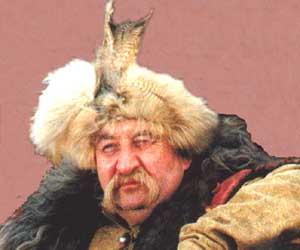 |
Returning from the Crimea, Jan Skrzetuski, an emissary of Prince Jeremy Wisniowiecki, saves the life of Bohdan Khmelnytsky (Chmielnicki), a Cossack Colonel. As he recounts this event at a nearby inn, he is set upon by Czaplinski, a sworn enemy of Khmelnytsky. Jan parries the attack easily, picking up the attacker bodily, forcing open a door and throwing him out onto the street. By his exhibition of physical prowess, which impresses those at the inn, Jan makes two, as it turns out later, faithful friends: Jan Zagloba and Longinus Podbipieta.
The three set out together for Lubinów, the residence of Prince Jeremy. On the way, they rescue two women pinned down by an overturned carriage, the noble woman Kurcewicz and her 18 year old niece, Helena. Jan falls in love with Helena at first sight. Later, when they get to Rozlogów, the Kurcewicz estate, Jan confesses his love to Helena and is assured by her the feelings are mutual. But Helena's hand in marriage has already been promised to Cossack Lt.Col. Jurko Bohun who is madly in love with her, and who, to the delight of the elder Kurcewicz, agreed that upon marrying Helena he would renounce her birthirght to Rozlogów. Jan scares the elder Kurcewicz by threatening to tell Prince Jeremy about the abuses that are occurring at Rozlogów and the injustice she is proposing to mete out to her niece. Once matters are stated in this fashion, his request for Helena's hand is readily accepted.
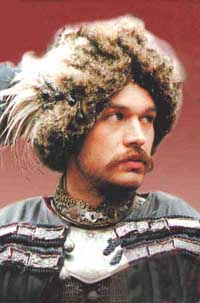 Jan Skrztuski |
When Jan reports back to Prince Jeremy, he is sent by him on another mission, this time to the Sicz area where he is to gather information about the mood of the Cossacks. On the way, he learns of Khmelnytsky's plans for an uprising and sends his orderly, the clever Rzedzian, to Rozlogów with a letter for the elder Kurcewicz asking that she and her whole family take refuge in Lubinów. As Rzedzian makes his way to Rozlogów, Jan's detachment is attacked and decimated, and Jan himself is taken prisoner. He is ransomed from the hands of Tuhaj-bej, the head of the Tartars who have come to assist the Cossacks, by Bohdan Khmelnytsky, the very leader of the uprising, who recognizes Jan as his recent rescuer. Jan, ill, is able to watch the battle of Zólte Wody (Yellow Waters).
Freed with a safe-conduct pass and a Colonel's staff, given to him by Khmelnytsky, he journeys to Rozlogów and to his horror finds there only smoldering ruins. It turns out that Rzedzian, and the letter he was carrying, had fallen into the hands of Bohun, who learning from the letter that the elder Kurcewicz had broken her promise to him, set out for Rozlogów, taking terrible vengeance in which the elder Kurcewicz and her sons perish.
 Cossack cavalry |
Helena manages to escape, thanks to Zagloba who had earlier attached himself to Bohun's detachment. After many adventures, the two manage to reach the "impregnable" fortress of Bar.
Jan, delegated by Prince Jeremy to fight the revolting Cossacks, learns of this while near Zaslaw. As he is about to set out to his beloved, he learns that Bar has fallen. In the fortress, Bohun locates Helena who, seeing him, attempts to commit suicide. Bohun takes the gravely wounded Helena to Czarcie Jar, to Horpyna, a sorceress and shamaness he knows. He leaves Helena under the guard of Horpyna and her ugly brother, Czermis, while he himself goes back to take part in the fighting.
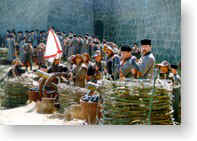 Defending Zbaraz |
Jan splits his detachment into four sections, each one starting out in a different direction. Zagloba, in command of one of the sections, accepts an invitation to a wedding where he has a blast of a time. He tells his stories and imbibes copiously. He wakes up hog tied to his sword with Bohun looking on. The latter orders him to be thrown into a pigsty, but Zagloba manages to free himself and tries to hide in the attic, an action that would be of scant help to him were it not for an attack by Wolodyjowski upon Bohun's company. Bohun gets away but soon runs into Zagloba and Wolodyjowski. In the duel with the latter, he is gravely wounded. Rzedzian, who is taking care of the wounded Bohun, gains his confidence and, by subterfuge, learns of the location of Helena. He steals Bohun staff of office and sets out to advise Jan of his discovery.
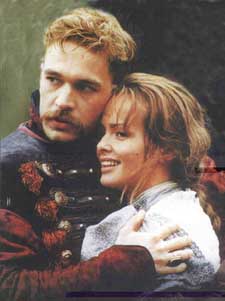 Jan and Halina together at last |
On the way he meets Wolodyjowski, Zagloba and Podbipieta and learns from them that Jan has set out for Kiev to look for Helena. Rzedzian, Wolodyjowski and Zagloba set our for Czarcie Jar and, after slaying Horpyna and her brother, free Helena. On the way back they are attacked by a company of Tartars allied to the Cossacks. Rzedzian flees with Helena while Zagloba and Wolodyjowski fight a rearguard action. Polish units come to their rescue and together they return to Zbaraz
During the siege, the four knights perform many valiant deeds. Podbipieta, who perishes in his attempt to reach the King, earlier manages to fulfill his vow and cuts off three pagan head in one swoop. Next, Jan sets out and when, exhausted he reaches the King, the latter decides to counterattack. A few days later, when Jan regains consciousness, he learns from Rzedzian that Helena is alive and living within the castle's walls. In the end they get together. Zagloba and Wolodyjowski arrive and the engagement of Helena and Jan is announced. As a "present", Jan is given possession of the captured Bohun, whom he frees. The film ends as Bohun rides away into the steppe.
| Info-Poland a clearinghouse of information about Poland, Polish Universities, Polish Studies, etc. |